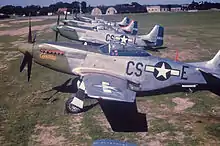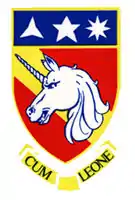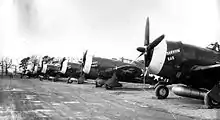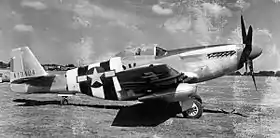359th Fighter Group
The 359th Fighter Group was a United States Army Air Force fighter unit that was active during World War II at RAF East Wretham.[1][2][3][4][5] The group had three fighter squadrons: the 368th, 369th, and 370th. The fighter group flew 346 combat missions over continental Europe and claimed 373 enemy aircraft in aerial duels and strafing attacks; probable destruction of 23; and damage to 185. It flew its last mission on 20 April 1945.
| 359th Fighter Group | |
|---|---|
 P-51 Mustangs of the 359th Fighter Group | |
| Active | 1943–1945 |
| Country | |
| Branch | United States Army Air Forces |
| Type | Group |
| Part of | Eighth Air Force |
| Garrison/HQ | RAF East Wretham |
| Commanders | |
| Notable commanders | Avelin P. Tacon Jr. |
| Insignia | |
| Insignia of the 359th Fighter Group |  |
| 368th Fighter Squadron | |
| 369th Fighter Squadron | |
| 370th Fighter Squadron | |
| Aircraft flown | |
| Fighter | P-47 Thunderbolt 1943-45 P-51 Mustang 1944-45 |
Training
The group was organized and trained at the fields in the Eastern United States: Westover Field, Massachusetts, January 1943; Grenier Field, New Hampshire, April 1943; Farmingdale Army Airfield, New York July 1943; and Westover Field, Massachusetts, August 1943.
The group was assigned to I Fighter Command, January 1943; New York Fighter Wing, July 1943; and Boston Fighter Wing, August 1943.
The group embarked on its overseas assignment from Westover Field on 2 October 1943, with the main body of troops and flying personnel leaving Westover by train and arriving at Camp Kilmer, NJ that afternoon.
RAF East Wretham

On 7 October 1943, the group boarded transports in NY Harbor, arriving in England on 19 October, being assigned to the 66th Fighter Wing of VIII Fighter Command. In November 1943, they were assigned to the 67th Fighter Wing.
The 359th Fighter Group entered combat in mid-December 1943 after five 359th Fighter Group pilots flew combat missions with the 78th Fighter Group.
Conversion to P-51 Mustang
The group began operations with Republic P-47 Thunderbolt aircraft, later converting to North American P-51 Mustang in April 1944. The role of the station in the general air war strategy was to operate and maintain its fighter aircraft against the enemy for a three-fold purpose: to provide escort and support to the U.S. bombers, to destroy the German Air Forces, both in aerial engagements and by low-level attacks on enemy airdromes, and to furnish close support to advancing Allied troops by strafing and dive-bombing enemy rail and motor transport, equipment and personnel and by flying offensive patrols over the battle lines.
At first, the group engaged primarily in escort activities to cover B-17/B-24 bombers that attacked airfields in France, and later expanded their area of operations to provide escort for bombers that struck rail centers in Germany and oil targets in Poland.
Invasion of Normandy
The group supported the invasion of Normandy during June 1944 by patrolling the English Channel, escorting bombardment formations to the French coast, and dive-bombing and strafing bridges, locomotives, and rail lines near the battle area.
Invasion of Holland

The 359th Fighter Group supported campaigns in France during July and August 1944, bombed enemy positions to support the airborne invasion of Holland in September.
They were attached to the 1st Bombardment Division in September 1944.
During the period July 1944 – February 1945, the group engaged chiefly in escorting bombers to oil refineries, marshalling yards, and other targets in such cities as Ludwigshafen, Stuttgart, Frankfurt, Berlin, Merseburg, and Brux. The 359th Fighter Group received a Distinguished Unit Citation for operations over Germany on 11 September 1944 when the group protected a formation of heavy bombers against large numbers of enemy fighters.
Battle of the Bulge
The group participated in the Battle of the Bulge (December 1944 – January 1945). The group flew missions to support the assault across the Rhine in March 1945, and escorted medium bombers that attacked various communications targets, February–April 1945.
Return to United States
The 359th Fighter Group returned to Camp Kilmer, New Jersey and was inactivated on 10 November 1945.
The group was redesignated 123d Fighter Group and allotted to Kentucky Air National Guard on 24 May 1946.
Notable pilots

Ray Wetmore was credited with 21.25 victories in aerial combat and ended the war as a 21-year-old major. His last victory was on March 15, 1945 near Wittenberg, destroying a Messerschmitt Me 163 Komet rocket fighter.[1]
Avelin P. Tacon Jr. was commander of the 359th Fighter Group and went on to become a major general in the US Air force.
Howard L. Fogg, an American artist specializing in railroad art, flew 76 combat missions with the 359th Fighter Group and was awarded the Air Medal with three clusters and the Distinguished Flying Cross with one cluster.[6]
Oscar Randolph Fladmark flew 64 combat missions with the 359th and received the Air Medal with ten Oak Leaf Clusters. He flew an additional 100 missions during the Korean War and received the Distinguished Flying Cross.
References
![]() This article incorporates public domain material from the Air Force Historical Research Agency website http://www.afhra.af.mil/.
This article incorporates public domain material from the Air Force Historical Research Agency website http://www.afhra.af.mil/.
- Jack H Smith (20 October 2012). 359th Fighter Group. Bloomsbury Publishing. ISBN 978-1-78200-535-3.
- Thomas H. Raines (1978). 359th Fighter Group, 1943-1945. Lulu.com. ISBN 978-1-105-96875-4.
- Janet Fogg; Charlotte Baldridge; Richard Fogg (6 June 2017). A Manifest Spirit: The 359th Fighter Group 1943-1945. CreateSpace Independent Publishing Platform. ISBN 978-1-5467-9163-8.
- Jack H. Smith (1997). Mustangs & Unicorns: A History of the 359th Fighter Group. Pictorial Histories Publishing Company. ISBN 978-1-57510-029-6.
- Kent D. Miller (1987). Jigger, Tinplate & Redcross: The 359th Fighter Group in World War Two. Academy Publishing Corporation.
- Richard P. Fogg (28 July 2011). Fogg in the Cockpit: Howard Fogg Master Railroad Artist, World War II Fighter Pilot. Casemate. ISBN 978-1-61200-004-6.
Bibliography
- Fogg, Janet and Fogg, Richard Tales from the 359th Fighter Group. FA LLC, 2019. ISBN 978-1796444643.
- Baldridge, Charlotte and Fogg, Janet and Fogg, Richard A Manifest Spirit: The 359th Fighter Group 1943-1945. FA LLC, 2017. ISBN 978-1546791638.
- Freeman, Roger A. Airfields of the Eighth: Then and Now. After the Battle, 1978. ISBN 0-900913-09-6.
- Freeman, Roger A. The Mighty Eighth: The Colour Record. Cassell & Company, 1991. ISBN 0-304-35708-1.
- Maurer, Maurer, Air Force Combat Units of World War II, Office of Air Force history (1961). ISBN 0-405-12194-6
- Maurer, Maurer, Combat Squadrons of the Air Force, World War II, Office of Air Force history (1982). ISBN 0-8317-1501-4
External links
| Wikimedia Commons has media related to 359th Fighter Group (United States Army Air Forces). |
- "359th Fighter Group 1943-1945". 359th Fighter Group on Facebook.
- "359th Fighter Group". American Air Museum in Britain. Imperial War Museums. Retrieved 2018-08-05.
- "359th Fighter Group". Little Friends. Retrieved 2018-08-05.